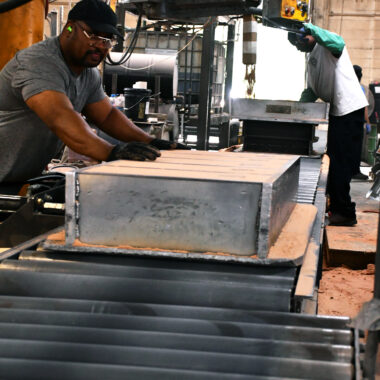Aluminum Casting Proficiency: Strategies to Elevate Your Manufacturing Process
Aluminum Casting Proficiency: Strategies to Elevate Your Manufacturing Process
Blog Article
Study the Globe of Aluminum Spreading: Understanding the Various Techniques
Aluminum spreading is a fundamental procedure in the production sector, with numerous approaches employed to create detailed and accurate parts. Comprehending the various techniques used in light weight aluminum casting can offer important insights into the capabilities and constraints of each method. From the conventional sand casting technique to the sophisticated die casting procedure, each method uses one-of-a-kind advantages depending upon the requirements of the task. Exploring these varied techniques can provide a detailed sight of the possibilities within the world of light weight aluminum spreading and exactly how each technique adds to shaping the contemporary production landscape.
Sand Casting Technique
Sand spreading, a widely-used method in aluminum casting processes, entails developing molds made of compressed sand for pouring liquified steel. This method is highly functional and cost-efficient, making it a popular option for various industries. The process starts with the development of a pattern, usually made from wood or steel, which is after that pressed right into the sand to leave a perception. The sand combination, generally silica sand combined with a binder like clay, is tightly loaded around the pattern to develop a mold dental caries. When the mold prepares, it is securely placed in a flask and molten light weight aluminum is put into the dental caries.
After the steel has cooled down and strengthened, the sand mold is broken away to reveal the aluminum spreading. Sand spreading permits for the manufacturing of intricate shapes and huge parts that might be challenging or costly to create utilizing other techniques. It is also a lasting strategy as the sand can be recycled and made use of numerous times, minimizing waste in the casting process.
Long-term Mold Technique

One considerable advantage of the Irreversible Mold Strategy is the enhanced dimensional precision it provides. The steel mold and mildew allows for tighter tolerances and better details in the last light weight aluminum spreadings contrasted to sand spreading approaches. This accuracy makes it a recommended selection for applications where tight dimensional control is vital, such as in the auto and aerospace sectors.

Pass Away Casting Refine

Investment Casting Technique
Using a precision casting method, Investment Casting Approach entails developing complex aluminum components by putting liquified metal into a ceramic mold. This procedure, likewise understood as lost-wax casting, starts with the development of a wax pattern of the preferred part. This wax pattern is after that covered with a ceramic material to create a covering. When the ceramic shell is set, it is heated up to remove the wax, leaving a hollow ceramic mold and mildew.
Investment spreading is commonly utilized for making components in markets where detailed designs and tight resistances are needed, such as aerospace, auto, and medical equipment. The adaptability and accuracy of the Financial investment Casting Approach make it an important method you could look here in the world of light weight aluminum casting.
Lost Foam Casting Technique
Having checked out the elaborate precision of Investment Casting Strategy, the emphasis currently shifts to the ingenious approach of Lost Foam Spreading in light weight aluminum part production. Lost Foam Spreading, likewise understood as evaporative pattern spreading, is a modern-day technique where a foam pattern of the desired component is created and after that covered with a refractory product.
Furthermore, Lost Foam Spreading is an economical procedure as it minimizes the need for cores and permits for the manufacturing of lightweight elements. Despite its advantages, Lost Foam Spreading requires cautious control of the spreading procedure to guarantee and protect against issues her latest blog high quality parts.
Conclusion
In verdict, light weight aluminum casting uses a variety of approaches such as sand casting, long-term mold and mildew strategy, die casting, investment spreading, and shed foam casting. Each technique has its very own benefits and applications, making light weight aluminum casting a functional and commonly utilized procedure in numerous sectors. Understanding the differences between these approaches is essential in choosing the most appropriate spreading method for details production requirements.
Sand casting, a widely-used technique in aluminum casting procedures, involves producing molds made of compacted sand for pouring molten metal. aluminum casting.The Permanent Mold Method, like sand spreading, is one more common technique utilized in aluminum casting processes, providing distinct advantages in terms of mold reusability and dimensional precision. The metal mold allows for tighter tolerances and finer information in the last light weight aluminum spreadings contrasted to sand spreading approaches. The 2 primary types of die casting are chilly chamber die casting and warm chamber pass away spreading, each appropriate for different types of aluminum alloys.In conclusion, aluminum casting offers a selection of approaches such as sand spreading, long-term mold technique, die spreading, financial investment spreading, and lost foam spreading
Report this page